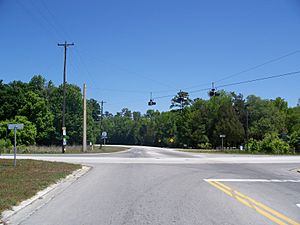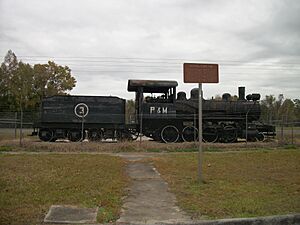Gulf Hammock, Florida facts for kids
Gulf Hammock is a small place in Levy County, Florida, United States. It's called an unincorporated community, which means it's not officially a town or city with its own local government. It's named after the big swampy area nearby, also called Gulf Hammock.
You can find Gulf Hammock where two main roads, US 19-98 and County Road 326, cross paths. It's also close to the Wekiva River. This spot is about 6 miles (10 km) southeast of a place called Otter Creek.
Contents
History of Gulf Hammock
Early Settlement and Growth
People first settled in the Gulf Hammock area around 1846. They built homes near where a north-south road crossed the Wekiva Run. This crossing was first known as Walker Landing.
After the Civil War, many freedmen (people who were formerly enslaved) bought land here. They started their own farms and built new lives. In the 1870s, a hunting lodge called the Wingate Hotel was in the area. It was later turned into a barn.
Lumber and Company Town Life
In the early 1900s, Gulf Hammock was a small community. It had a post office, a general store, and a school. The Otter Creek Lumber Company began working in the area around 1905.
In 1910, S. J. Gunn bought the Otter Creek company and a large amount of land. He then started a factory in Gulf Hammock that made wooden crates. When the Atlantic Coast Line Railroad opened a train line through the area in 1913, the community moved closer to the railroad tracks.
In 1916, a post office opened and was named "Gunntown" after S. J. Gunn. Later, in 1926, a businessman named Edwin Wiley Grove and two brothers, James and William Dowling, bought the crate factory. They also bought all the land in Gulf Hammock and a huge amount of timber land.
That same year, the post office name was changed back to "Gulf Hammock." This name is still used today. Edwin Grove passed away in 1927, and his company, Grove-Dowling, faced financial problems. In 1930, another company, Patterson-McInnis, bought all of Grove-Dowling's properties.
Life in a Company Town
By 1929, about 1,500 people lived in Gulf Hammock. It was a "company town," which meant that one company owned almost everything. The company owned all the houses, two churches (one for white residents, one for Black residents), hotels, and a hospital.
They also owned the crate factory, a sawmill, and a planing mill. There was a large company store, called a commissary, and a garage that also sold Ford cars. The commissary was very big and had many goods, attracting shoppers from other towns.
The Orange Blossom Hotel, built in 1927, hosted popular Saturday night dances. People from nearby counties would come to enjoy them. The company paid the salaries for the doctor, nurses, and pharmacist. They also helped pay the white teachers and the white preacher.
In the 1930s, Patterson-McInnis had about 600 employees. Their sawmill was very powerful and could produce a lot of lumber each day. In 1940, the Georgia-Pacific Company bought Gulf Hammock and all the timber lands from Patterson-McInnis.
Later Years and Preservation
In 1969, Georgia-Pacific gave some land to the Florida Department of Transportation. This land, located at the corner of US 19-98 and what was then Secondary State Road 326, became a park.
This park is home to an old steam train engine, the Patterson-McInnis Railroad steam locomotive number three. The train tracks that ran through Gulf Hammock were slowly closed down by CSX in the mid-1980s and later removed.
Since the late 1900s, Gulf Hammock has been surrounded by protected natural areas. These include the Goethe State Forest, Gulf Hammock Wildlife Management Area, Waccasassa Bay Preserve State Park, Cedar Key Scrub State Reserve, and Devils Hammock Wildlife Management Area. These areas help protect the local wildlife and environment.



